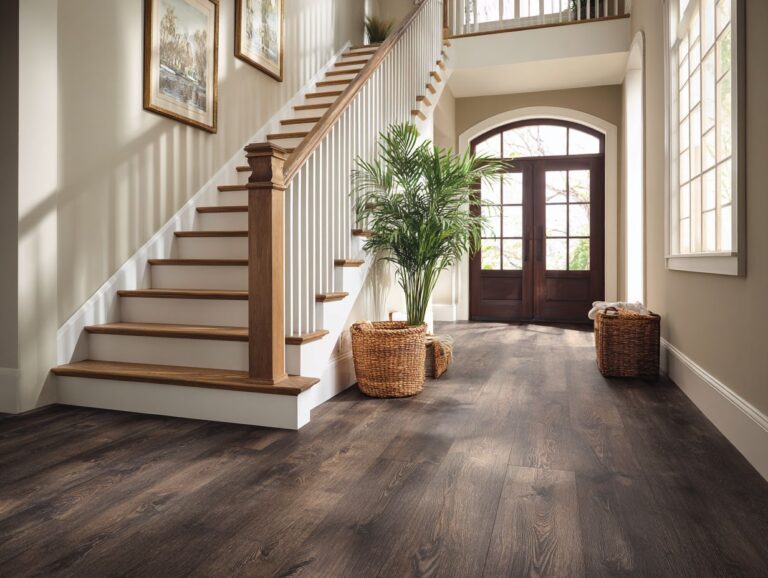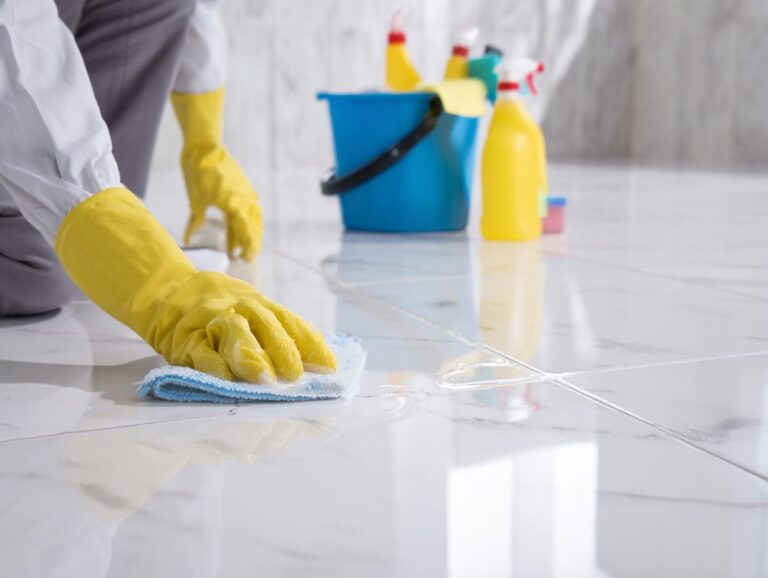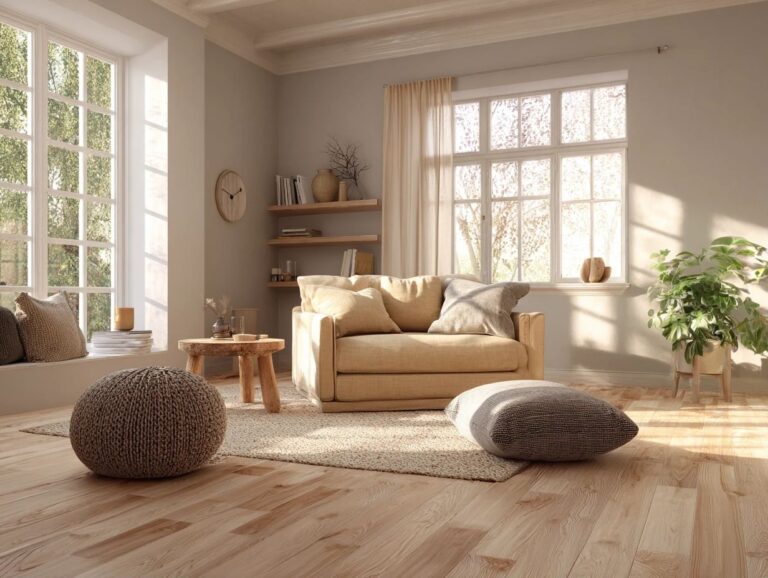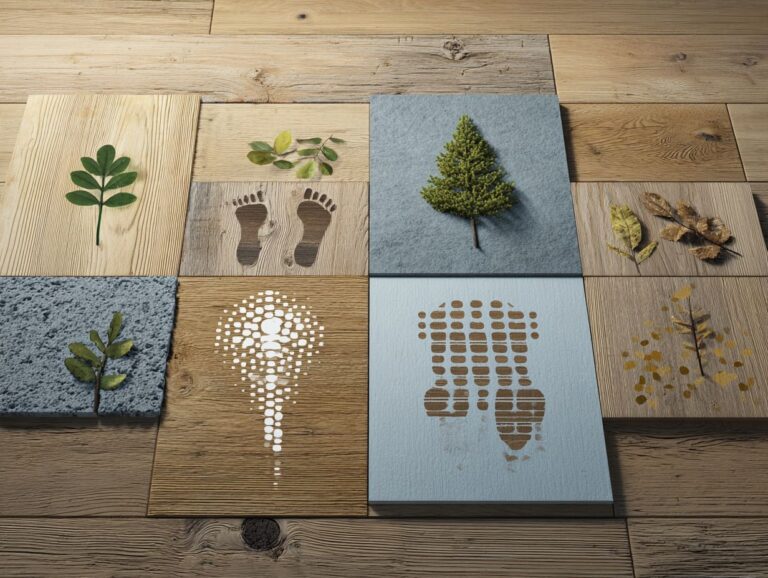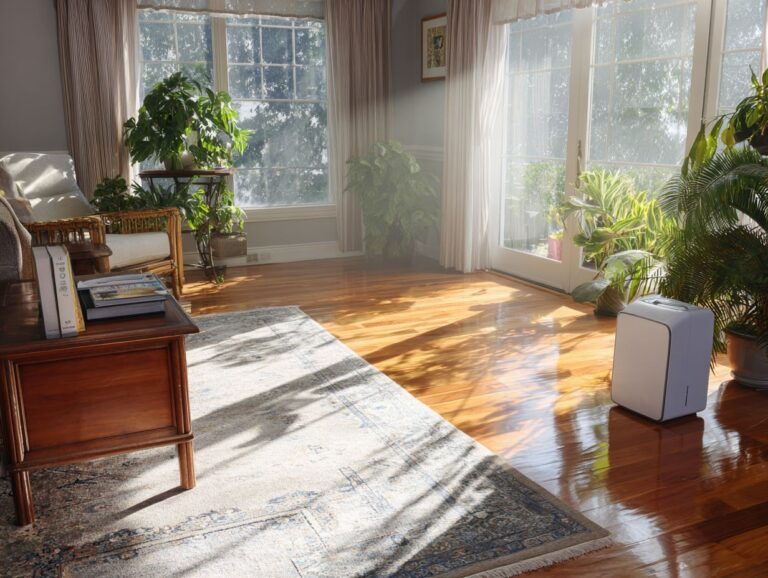Basement Flooring Solutions – Moisture and Mold Prevention
Choosing basement flooring that resists moisture is important to stop mold from growing. Chris Hartman recommends solutions like waterproof flooring, luxury vinyl planks, porcelain tiles, and ceramic tiles as effective barriers against dampness. This article looks at the best flooring options for basements, focusing on keeping the area dry and healthy while making it look good. Find useful advice and product information to make your basement free from mold.
Key Takeaways:
Contents
- Understanding Basement Moisture Issues
- Basement Flooring Moisture Statistics
- Types of Basement Flooring Solutions
- Moisture and Mold Prevention Techniques
- Choosing the Right Flooring for Your Basement
- Maintenance of Basement Flooring
- Frequently Asked Questions
- What are some common basement flooring solutions for moisture and mold prevention?
- How do I know if my basement flooring is at risk of moisture and mold issues?
- Can I install carpet in my basement to prevent moisture and mold?
- Are there any specific maintenance tasks I should regularly perform to prevent moisture and mold in my basement flooring?
- What steps can I take to prepare my basement for moisture and mold-resistant flooring?
- Is it necessary to hire a professional to install basement flooring to prevent moisture and mold?
Importance of Moisture and Mold Prevention
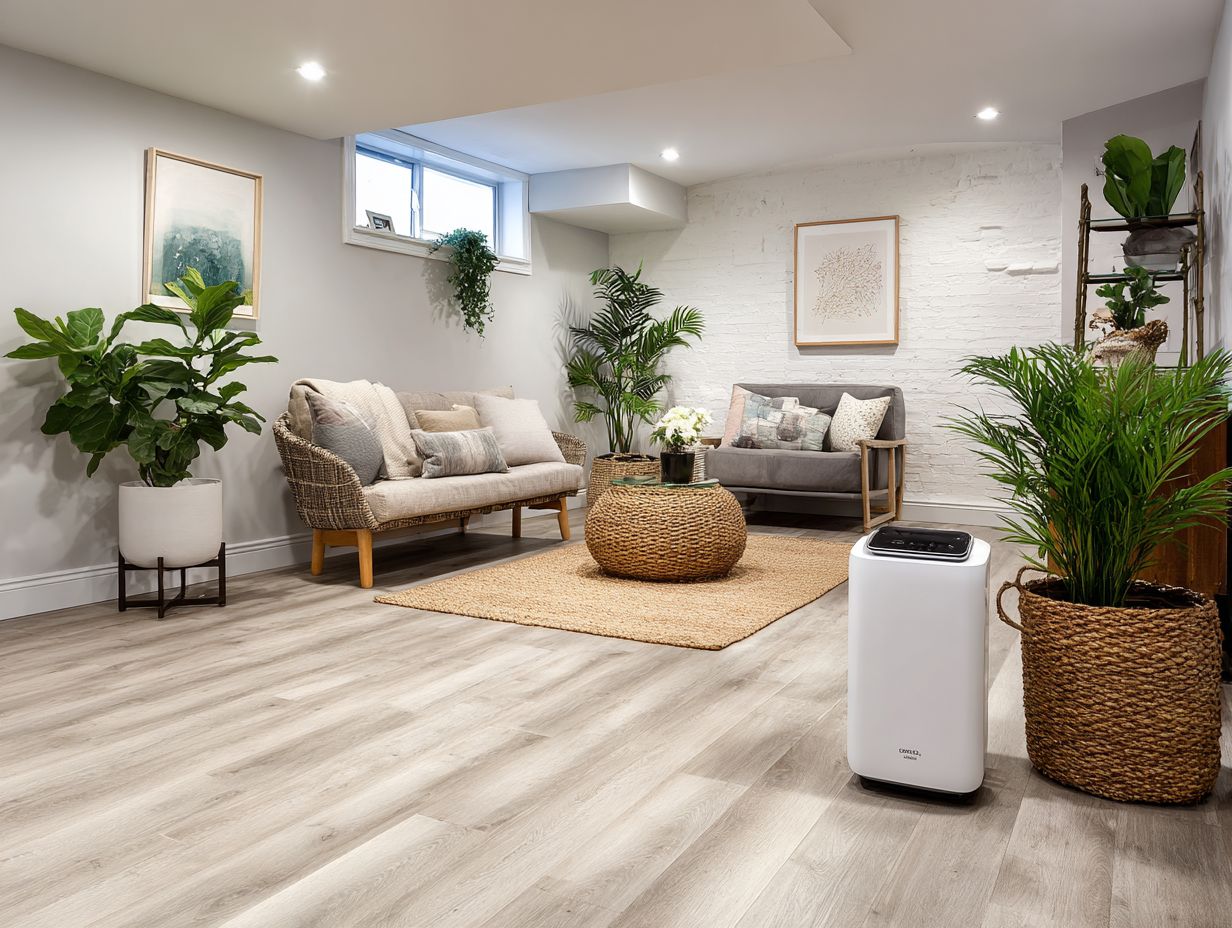
Stopping moisture and mold in basements is important for keeping the air clean and protecting the floor materials.
To effectively manage moisture, aim for indoor humidity levels below 50%. Use a hygrometer to monitor humidity, and consider a dehumidifier for spaces that exceed this threshold.
Regularly inspect and maintain HVAC systems, ensuring they are equipped with HEPA filters to trap mold spores and other allergens. Sealing cracks in walls and floors with waterproof sealants can prevent moisture intrusion.
For detailed advice, check the EPA’s guidelines on controlling indoor moisture. These offer practical steps to create a healthier basement environment.
Overview of Common Basement Flooring Options
Homeowners can choose from a variety of basement flooring options including luxury vinyl plank, sealed concrete, and carpet tiles, each offering unique benefits.
For moisture resistance and durability, consider thermal products like ThermalDry, which is specifically designed for wet areas and offers a customizable look with its interlocking tiles.
Nature Stone offers a nice, concrete-like look and great resistance to water, which makes it good for wet basements. Luxury vinyl plank, available from brands such as Shaw and Armstrong, stands up to changes in humidity while mimicking wood or stone.
Sealed concrete is an affordable option that stops moisture from getting through, though it can feel cold, so rugs can make it more comfortable.
Carpet tiles, like those from Mohawk, allow for easy replacement in case of water damage.
Understanding Basement Moisture Issues
Knowing what leads to moisture problems in basements is key to stopping them and picking the right flooring.
Basement Flooring Moisture Statistics
Basement Flooring Moisture Statistics
Moisture Testing and Flooring Options: Humidity Issues
Moisture Testing and Flooring Options: Moisture Impact and Solutions
The Basement Flooring Moisture Statistics give important information about the problems and fixes related to moisture when installing basement flooring Knowing these data points is important for making sure flooring materials last and work well in places where moisture can be a problem.
Moisture Testing and Flooring Options highlight two primary concerns: Humidity Issues and Moisture Impact and Solutions.
- Humidity Issues: The data indicates that 8.0 humidity-related failures occur, showcasing the significance of addressing moisture to prevent flooring damage. To mitigate these risks, a 100% Recommended RH (Relative Humidity) Test is advised before any installation. This testing checks that the subfloor is in good condition, avoiding expensive repairs or replacements caused by moisture damage.
- Moisture Impact and Solutions: The Effectiveness of Epoxy as a moisture barrier is reported at 95.0%. Epoxy coatings work well to seal floors and prevent moisture, making them a great option for basements. Additionally, Vinyl’s ability to handle moisture issues stands at 75.0%. Vinyl flooring offers a practical solution, particularly in areas prone to humidity, though it may require additional measures to manage higher moisture levels effectively.
These statistics highlight the need for careful moisture testing and choosing the right flooring materials for basements. Following the suggested methods, like checking relative humidity levels and using materials that resist moisture such as epoxy and vinyl, can greatly lower the chances of flooring problems and make sure they last a long time.
Causes of Moisture in Basements
Basements commonly suffer from moisture due to hydrostatic pressure, poor drainage, and inadequate ventilation. These factors can lead to significant issues such as mold growth and structural damage.
To combat hydrostatic pressure, consider installing a French drain system, which typically costs between $2,000 and $5,000. A sump pump can help remove accumulated water, with installation costs around $1,000 to $2,500.
Better airflow is important; dehumidifiers help lower moisture levels. Using these methods together can keep your basement dry and useful.
Signs of Moisture Problems
Early detection of moisture problems can save homeowners from significant repairs and health hazards associated with mold and mildew.
Homeowners should regularly check for signs of water problems. Key indicators include peeling paint, which suggests trapped moisture beneath the surface, and damp spots that can often be felt on walls.
Musty odors signal mold presence, while visible mold growth confirms it’s time to act. A thorough evaluation checklist could include:
- Checking basements and crawl spaces
- Inspecting around windows and doors
- Monitoring plumbing for leaks
Regularly assessing these areas can help catch problems early, preventing costly repairs and ensuring a healthy living environment.
Impact of Moisture on Flooring Materials
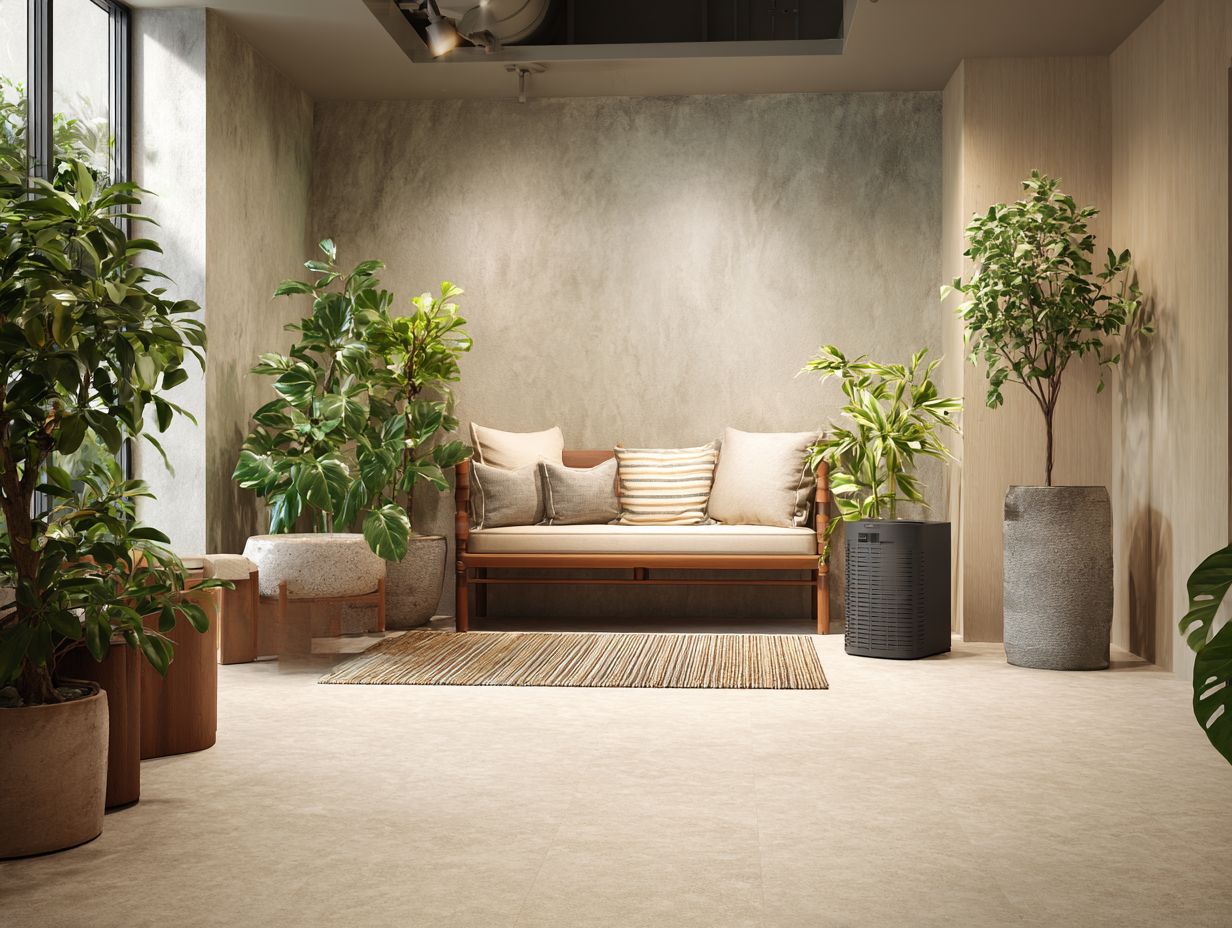
Too much moisture can damage different types of flooring, causing expensive repairs.
For instance, luxury vinyl plank (LVP) begins to warp at moisture levels as low as 5%. To mitigate these risks, install moisture barriers during your flooring project to create a protective barrier against ground moisture.
Make sure there is good airflow in damp places such as bathrooms and kitchens. Regularly check humidity levels using a hygrometer and consider dehumidifiers in high-moisture environments.
Performing routine inspections can help you catch early signs of water damage, saving you from more extensive repairs down the line.
Types of Basement Flooring Solutions
Choosing the appropriate flooring for your basement is essential to make sure it looks good and works well. For those considering various designs, see also: our insights on Vinyl Flooring Pattern Options that offer diverse wood and stone looks to suit any basement aesthetic.
Concrete Flooring
Concrete flooring is a strong, budget-friendly option for basements, especially when sealed to prevent moisture.
Sealed concrete is strong and easy to maintain, ideal for areas with high moisture. For a good seal, apply a water-based acrylic sealer on a well-cleaned surface. This usually costs $3 to $5 per square foot.
For DIY enthusiasts, the installation process includes:
- Preparing the floor
- Applying the sealer with a roller
- Allowing it to cure for at least 24 hours
The combination of toughness and resistance to stains means your basement floor will remain in good shape for years with minimal upkeep.
Vinyl Flooring
Luxury vinyl plank (LVP) is a highly popular option for basement flooring due to its stylish appearance and waterproof features.
A major advantage of LVP is that it does not get damaged by water, which makes it perfect for basements that often have moisture.
Its ease of installation allows homeowners to save on labor costs; many brands, such as Greatmats and SPC, offer planks that can be installed as a floating floor without glue or nails.
With a price range of $2 to $7 per square foot, LVP offers a flexible design option, allowing for various aesthetics from wood to stone finishes that fit any dcor beautifully.
Carpet Tiles
Carpet tiles provide a comfortable and practical flooring option for basements, especially in areas with low moisture exposure.
They are easy to install, requiring no professional tools or adhesive, which makes DIY projects very manageable. For instance, you can simply peel off the backing and place them in your desired configuration.
If a tile gets stained or damaged, you can replace just that piece rather than the entire floor. Brands like StayLock offer options that resist moisture, typically priced between $1 and $4 per square foot, making them a cost-effective choice for basements.
Epoxy Coatings
Epoxy coatings create a seamless, waterproof finish ideal for basement floors, enhancing both aesthetics and durability.
To apply an epoxy coating, start with surface preparation: clean the floor thoroughly, repair cracks, and etch the surface to promote adhesion.
The curing time typically ranges from 24 to 48 hours, depending on the specific product used. Expect costs between $3 to $12 per square foot, depending on quality and region.
Benefits include easy cleaning and high resistance to chemicals and moisture, making it a practical choice for high-traffic areas.
For best results, consider applying a topcoat for added durability and UV protection.
Moisture and Mold Prevention Techniques
Using proper methods to prevent moisture and mold helps keep basement flooring lasting longer and protects health.
Proper Drainage Systems
A well-designed drainage system can effectively manage water flow and prevent moisture-related damage in basements.
To get the best results, focus on two main types of drainage systems.
- Interior French drains are installed within the basement, costing between $1,500 and $3,000. They involve digging a trench, laying perforated pipes, and covering with gravel.
- Exterior grading costs between $3,000 and $5,000 and involves reshaping the ground to guide water away from the building’s base.
For effective installation, always check local building codes and avoid shallow trenches to prevent clogs. Regularly inspecting and maintaining the system can help avoid costly repairs down the line.
Vapor Barriers Installation
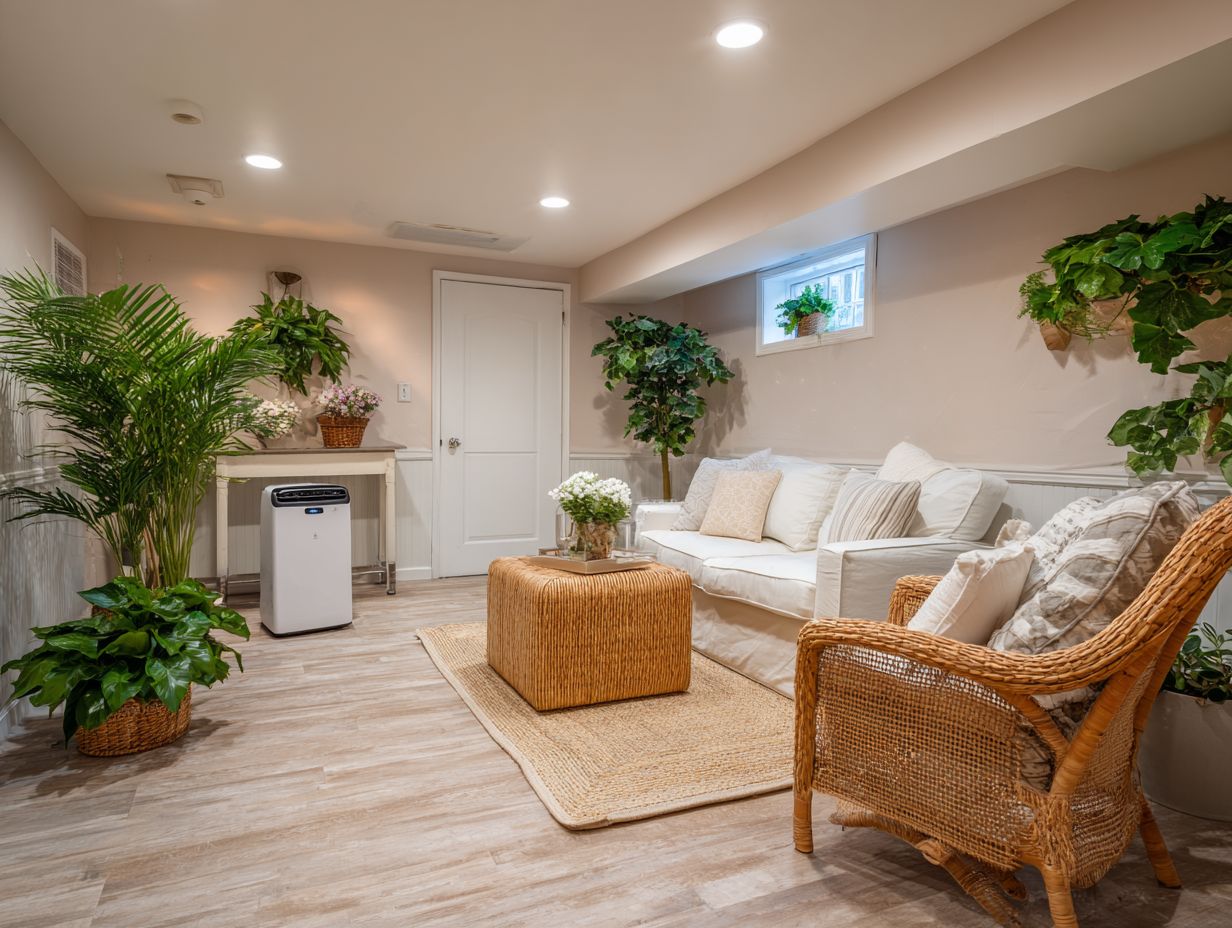
Installing vapor barriers is a fundamental step in preventing moisture from penetrating basement flooring and walls.
To begin, use polyethylene sheets, available for about $0.20 to $0.50 per square foot, ensuring a thickness of at least 6 mils for durability.
Collect the needed items: a utility knife for cutting, duct tape for sealing seams, and a measuring tape to get the right sizes.
When applying the barrier, avoid common mistakes such as leaving gaps or failing to overlap sheets by at least 12 inches. Work from the bottom up and tuck the edges securely under baseboards to create a watertight seal.
With proper installation, you can significantly reduce moisture-related issues.
Dehumidifiers and Ventilation
Utilizing dehumidifiers and proper ventilation systems can significantly reduce humidity levels in basements, preventing moisture issues.
To effectively control humidity, keep levels between 30-50%. The Frigidaire 50-Pint Dehumidifier, priced around $200, is excellent for medium-sized basements due to its efficiency and built-in humidity controls.
To ventilate your home, think about putting in a QuietCool Whole House Fan. It runs quietly and moves air around well, helping to cut down on moisture. Utilizing a hygrometer, like the AcuRite 00613, allows you to monitor humidity levels in real-time, ensuring your mitigation efforts are on point.
Regularly checking and adjusting your systems will help maintain optimal conditions and protect your basement from moisture-related issues.
Waterproofing Products
Using specific waterproofing products keeps basement floors safe from moisture.
Products like Drylok (around $30 per gallon) can be easily applied with a brush or roller. For tougher jobs, consider applying a sealant like RadonSeal, which penetrates deeply to prevent moisture.
These products protect against water damage and fight mold growth, improving the strength of your basement. Doing regular upkeep on these treatments can make them last longer. Reapply every few years to continue protection.
Choosing the Right Flooring for Your Basement
Choosing the best flooring for your basement requires thinking about how well it works and how it looks.
Factors to Consider
Homeowners should evaluate factors such as moisture resistance, cost, and style when selecting basement flooring options.
Additional critical factors include durability and installation ease.
For example, luxury vinyl planks resist moisture, are budget-friendly, and come in many styles, which is why they are often chosen for basements. On the other hand, carpet tiles offer comfort and ease of installation, allowing for easy replacement if damaged.
To visualize options, homeowners can use design tools like RoomSketcher, which helps compare different flooring layouts and materials.
Picking what you like and considering the space you have will give you a good outcome.
Cost vs. Benefits
Evaluating the cost versus benefits of various basement flooring solutions can help homeowners make informed decisions.
Different flooring options range in price from $2 to $12 per square foot.
Vinyl flooring, priced at about $2-$5, is water-resistant and simple to care for, which makes it a common option.
For a more durable option, laminate runs about $3-$6 per square foot, providing a stylish look while resisting scratches.
Hardwood flooring, though pricier at $8-$12, can significantly increase your home’s resale value.
To maximize your investment, consider that high-quality flooring can yield a return on investment of 70% to 80% when selling your home.
Maintenance of Basement Flooring
Maintaining your basement floor will make it more durable and improve its appearance. For those interested in learning more about enhancing flooring comfort and sustainability, our guide on cork flooring benefits might be of interest.
Regular Inspections
Regular checks can find possible moisture problems and damage in basement floors.
Arrange checks every six months to confirm that all is organized. Key areas to check include visible cracks in the flooring, signs of dampness along the walls, and any evidence of mold growth.
An effective inspection checklist could include items like:
- Inspect for cracks (width and depth)
- Look for discoloration or peeling paint (indicating moisture)
- Test moisture levels with a hygrometer
Allocate about an hour for each inspection, and document findings to track changes over time, enabling proactive repairs before problems escalate.
Cleaning and Care Tips
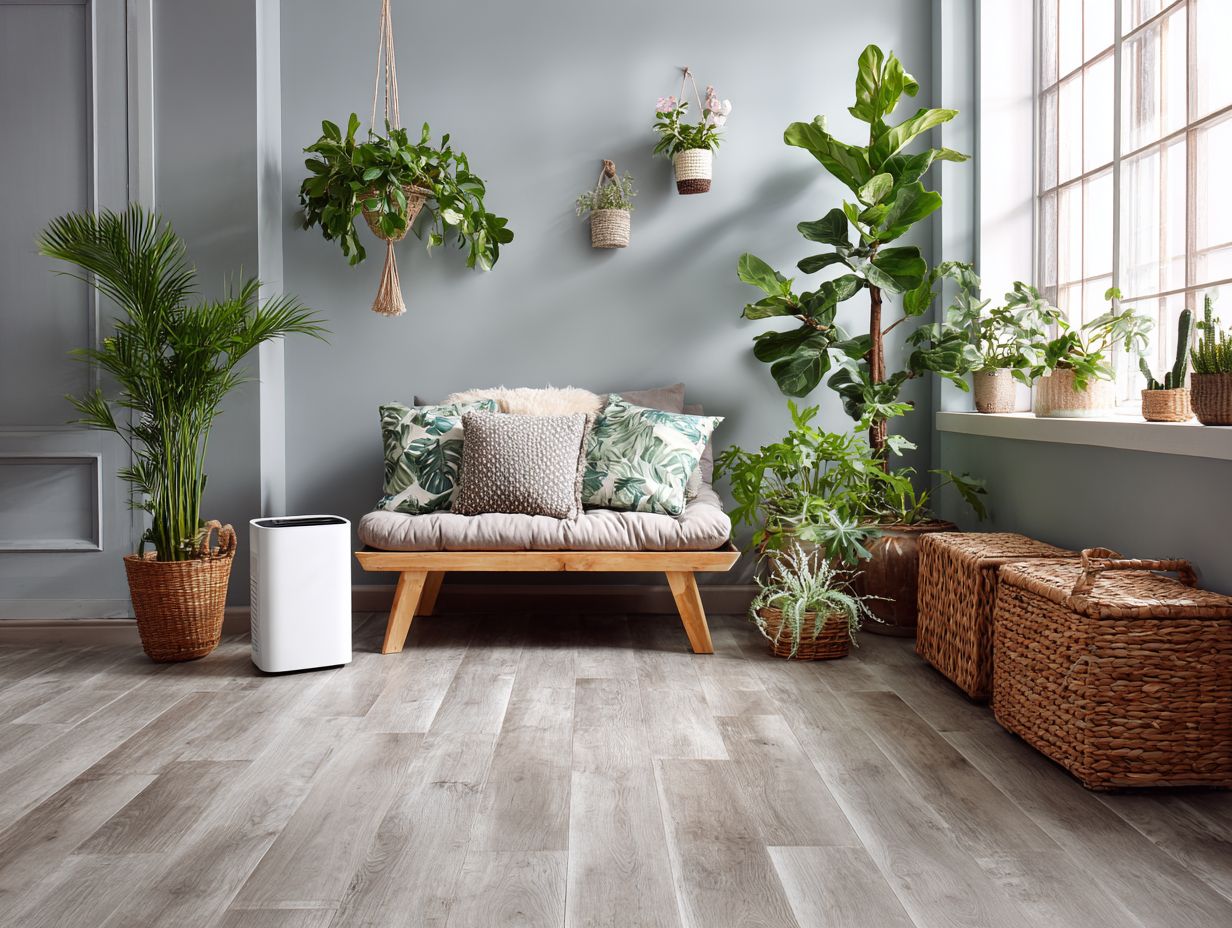
Proper cleaning and care can prevent premature wear and maintain the appearance of basement flooring.
For effective maintenance, tailor your cleaning approach based on the flooring material.
- Clean vinyl floors every two weeks with a damp mop and mild soap to get rid of dirt and stains.
- Carpet tiles require weekly vacuuming to remove debris, with occasional steam cleaning for deep stains.
- If you have laminate flooring, use a microfiber mop with a mild cleaner once a month.
Remember to look for areas of wear and clean those spots when necessary. This routine keeps your flooring looking good and lasts longer.
Final Thoughts on Basement Flooring Solutions
The best basement flooring options mix good looks, strength, and moisture management to improve your home.
Think about choices like vinyl plank flooring, which is waterproof and available in different designs, allowing it to look like wood or tile.
For a more luxurious feel, epoxy coatings provide a seamless, durable surface that’s resistant to stains and moisture. Rubber flooring tiles are excellent for gym settings, offering cushioning and slip-resistance.
When selecting your flooring, evaluate your budget, maintenance preferences, and intended use. Visit local showrooms to see samples, or request swatches online to gauge how they fit with your basement’s ambiance.
Frequently Asked Questions
What are some common basement flooring solutions for moisture and mold prevention?
Some popular options include epoxy coatings, ceramic or porcelain tile, luxury vinyl planks, and rubber flooring. These materials are resistant to moisture and can help prevent mold growth in your basement.
How do I know if my basement flooring is at risk of moisture and mold issues?
Signs of moisture and mold problems in your basement flooring can include discoloration, musty odors, and visible mold growth. If you see any of these problems, you should fix them quickly to avoid more harm.
Can I install carpet in my basement to prevent moisture and mold?
Even if some carpets say they resist mold, it’s usually best to avoid using them in basements because there is a lot of moisture. Carpet can trap moisture and create an ideal environment for mold to grow, so it’s best to choose a different flooring option for this space.
Are there any specific maintenance tasks I should regularly perform to prevent moisture and mold in my basement flooring?
Yes, it’s important to regularly inspect and clean your basement flooring to prevent moisture and mold issues. This can include looking for water leaks, using a dehumidifier to manage humidity, and quickly cleaning up any spills or standing water.
What steps can I take to prepare my basement for moisture and mold-resistant flooring?
Before installing any type of basement flooring, it’s important to properly prepare the space. This may include sealing any cracks in the foundation, installing a vapor barrier, and ensuring proper ventilation to reduce moisture levels. These steps can help create a better environment for your chosen flooring solution to be effective in preventing moisture and mold.
Is it necessary to hire a professional to install basement flooring to prevent moisture and mold?
Although it’s wise to talk to an expert about home improvement projects, some basement flooring options are suitable for doing it yourself. For the best outcome and to make sure installation is done correctly without moisture and mold issues, it might be helpful to hire an expert.

